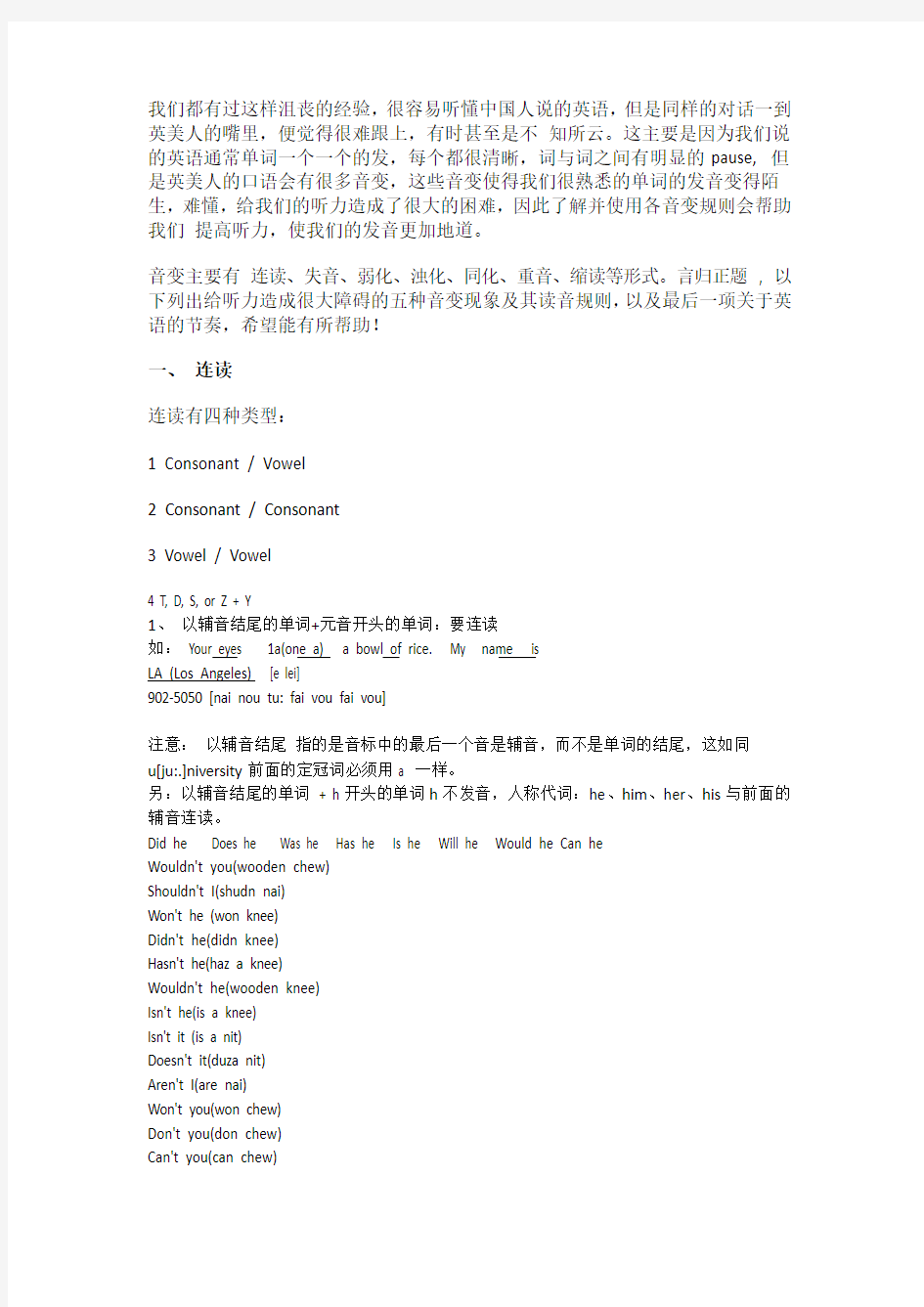

我们都有过这样沮丧的经验,很容易听懂中国人说的英语,但是同样的对话一到英美人的嘴里,便觉得很难跟上,有时甚至是不知所云。这主要是因为我们说的英语通常单词一个一个的发,每个都很清晰,词与词之间有明显的pause, 但是英美人的口语会有很多音变,这些音变使得我们很熟悉的单词的发音变得陌生,难懂,给我们的听力造成了很大的困难,因此了解并使用各音变规则会帮助我们提高听力,使我们的发音更加地道。
音变主要有连读、失音、弱化、浊化、同化、重音、缩读等形式。言归正题, 以下列出给听力造成很大障碍的五种音变现象及其读音规则,以及最后一项关于英语的节奏,希望能有所帮助!
一、连读
连读有四种类型:
1 Consonant / Vowel
2 Consonant / Consonant
3 Vowel / Vowel
4 T, D, S, or Z + Y
1、以辅音结尾的单词+元音开头的单词:要连读
如:Your eyes 1a(one a) a bowl of rice. My name is
LA (Los Angeles) [e lei]
902-5050 [nai nou tu: fai vou fai vou]
注意:以辅音结尾指的是音标中的最后一个音是辅音,而不是单词的结尾,这如同
u[ju:.]niversity前面的定冠词必须用a 一样。
另:以辅音结尾的单词+ h开头的单词h不发音,人称代词:he、him、her、his与前面的辅音连读。
Did he Does he Was he Has he Is he Will he Would he Can he
Wouldn't you(wooden chew)
Shouldn't I(shudn nai)
Won't he (won knee)
Didn't he(didn knee)
Hasn't he(haz a knee)
Wouldn't he(wooden knee)
Isn't he(is a knee)
Isn't it (is a nit)
Doesn't it(duza nit)
Aren't I(are nai)
Won't you(won chew)
Don't you(don chew)
Can't you(can chew)
Could you(ku d?u:)
Would you(wu d3ju)
Tell him to ask her….
Leave him For him
Give her a book. Giv-er a book.
Tell him to ask her. Tell-im to ask-er.
What will he do What will-i do
Where will he go Where will-i go
When will he come When will-i come
who will he meet who will-i meet
How will he know How will-i know
Has he gone Has-i gone
Had he done it before Had-i done it before
Must he go Must-i go
Can he do it Can-i do it
Should he leave Should-i leave
2、辅音+辅音的连读
如果前面的单词结尾的清辅音,后面单词开头是与之相对应的浊辅音,或者相反,只发后面的辅音
t-d t?-d?s-z ?-?p-b f-v k-g
si t down I don’t know(发音再次的老师都不会发出[t] 音)
I jus t didn't ge t the chance.
Bi g cake Da d tol d me Hu ge change Goo d night
3、元音+元音
当前面的单词以元音结尾,后面的单词以元音开头,两个元音连读,连读的方法是在中间加w或者加j.以ou结尾的元音后面一般加w。而以长元音i:结尾的后面加j
Go (w)away who (w)is so (w)honest do (w)I she (j)is
但发这两个音的时候不要太强太故作。不然的话还不如不发。
4、T, D, S, or Z + Y的连读:
当一个单词是以t d s z 结尾,后面的单词是以y(j)开头的话要连读:
4-1 t+y 连读成/t?/
Wha t’s y our name
Can’t you do it
I’ll le t you know.
4-2 d+y连读成/ d?u:/
Did you see it
How did you like it
Could you tell
4-3 s+y连读?
Yes,you are
Bless you
Guess your age
4-4 z+y连读成?
How’s your family
Who’s your friend
When’s your birthday
呵呵!我第一次知道这一连读规则时,兴奋不已,很容易的听懂了许多以前觉得很难以理解的句子,并且按照这种连读方式发音省力、轻松了许多。
二、失音
由于失去爆破是失音的一种现象,摩擦音也会被失去,所以统称为失音。
注意:爆破音并不是完全失去,仍然形成阻碍,把气流堵在里面,但不爆破,直接发出相邻的辅音。
Disappearing /T/
关于/t/失音问题:The sound /t/ tends to be unstable in many words and phrases. Sometimes it's there. Sometimes it isn't. There is a process called elision which deletes /t/ when it is preceded by a voiceless consonant and followed by any consonant except /h/. Here are some examples: Christmas last week most people act sensibly software international
Disappearing /d/
we saw that /t/ can disappear in certain circumstances. The same is true of /d/, but the circumstances are slightly different. If /d/ is preceded by a voiced consonant /b d g v D z Z dZ m n N l/ and it is followed by a consonant other than /h/, then it can be deleted (elided). Here are some examples: handbag old man used to
Taken together, the disappearance of /t/ and /d/ is called alveolar plosive elision.
三、浊化
1、[S] 后面的清辅音要浊化
[k] 浊化成[g] sky Discussion:
[t] 浊化成[d] Stand
[p]浊化成[b] speak Expression
还有[tr]—[dr] strike
2、美音中t 在单词的中间被浊化成[d]
如:writer,听起来和rider 的发音几乎没有区别
letter—ladder out of
2-1在单词的前面或后面就不浊化比如:Ted took ten tomatoes. first , coast, hot, late,fat, goat, hit, put, not, hurt,等。
2-2在过去式中ed的发音:在清辅音后面发t: laughed [la:ft], picked [pIkt], hoped [houpt], raced [reist], watched [wa: t?t], washed [wa: ?t]
在浊辅音后面发d : halved [h?vd], rigged [rigd], nabbed [n?bd], raised [reizd], smoothed [smu: ed]
Exceptions: wicked [wikd], naked [nakd], crooked [kr¨1d], etc
T或d后面发/id/ started founded
2-3 t和n连在一起的时候,由于口位差不多,通常t就不发音了。
1. interview -innerview
innernet
–twenny
–winner或winder
或ender
美国人和加拿大人发音为了省事,习惯清音浊化,尤其是[t]在单词的中间一定会浊化成[d],但英国人发音不会这样,这也是英音和美音的一大区别。了解这一浊化原则,会给听力带来一些帮助。
四、弱读
一般来说:
实词重读,如动词、名词、副词等;
虚词弱读,如介词、代词等
弱读的规则一般是:元音音节弱化成[?] 或[?]
比如说如下几个单词:for/to/some/does/of
查字典会发现这些词都至少有两种读音,如for:重读时[f?:] ,弱读时[f?] to有三种读法[tu:][t?][t] some也有三种读法[s?m][s?m][sm].does也有两种读法[d?z][d?z] of居然有四种读法[?v][?v][v][f],没想到啊!真是没想到啊!
举几个例子:
1、To的弱读:to的前面是辅音弱读成t或t ?today/t’dei/tonight/t’nait/
we have to/h?ft?/ go.
To的前面如果是元音,那就弱读成d或d?I go to/goud?/work
at a quarter to two We plan to do it.
2、for的弱读:在句中读/f?r/句末读/f ?:r/
This is for/f?r/ you. It's for/f?r/ my friend.
What is this for/f ?:r/ Who did you get it for/f ?:r/
3、and弱读成/n/
bread and butter
4、or弱读成/?r/Soup or/su:p?r/ salad left or right
5、are弱读成/?r/ What are you doing How are you
6、your弱读成/j?r/ How's your family Is this your car
还有很多,希望多听,细心体会。
综上所述,不难看出为什么我们跟不上老外说的英语了,了解了这些不仅能提高我们的口语能力,同时提高了我们的听力。哈哈哈!